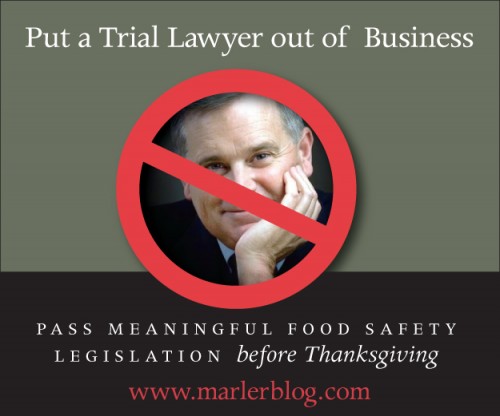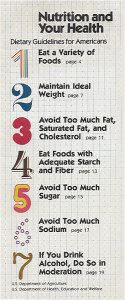I’ve heard rumors that some members of the Dietary Guidelines Advisory Committee (DGAC) believe that commentators did not give a fair shake to their recently released report (see previous post).
I complained that the DGAC report is difficult to read because its pieces are presented online in a great many individual pdf files that must be downloaded separately. Fortunately, Cornell student Daniel Green created a single Web-based file.
I have now read the report, or at least browsed through its 699 pages, and I agree that it is better than it first appeared and deserves a revisit (which I am doing in two parts, the second tomorrow).
As with previous Dietary Guidelines, both politics and science underlie this report. The science components of this report are stunning—as good as such things get—and make this document an invaluable resource.
Why did everyone, including me, miss this? Politics, of course. The politics appear unchanged from previous versions (for that, see Food Politics).
The science in this report gives clear guidance for action. But the report obfuscates its most important messages.
The Executive Summary makes the advice seem dull. The Summary is the part everyone reads first and often the only part anyone reads. Try this:
The 2010 DGAC report concludes that good health and optimal functionality across the life span are achievable goals but require a lifestyle approach including a total diet that is energy balanced and nutrient dense…SoFAS (added sugars and solid fats) contribute approximately 35 percent of calories to the American diet….Reducing the intake of SoFAS can lead to a badly needed reduction in energy intake and inclusion of more healthful foods into the total diet.
Obesity, it says, is a big problem. The food environment is a big problem. What to do about them? SoFAS.
The report introduces a new euphemism, SoFAS (Solid Fats and Added Sugars). The meaning of added sugars is obvious. But what are solid fats? For that, you must wait until page 183 (on the Daniel Green file):
Solid fats are fats that are solid at room temperature. Solid fats come from many animal foods and can be made from vegetable oils through hydrogenation. Some common solid fats are butter, beef tallow (tallow, suet), chicken fat, pork fat (lard), stick margarine, and shortening. Foods high in solid fats include many cheeses, creams, ice cream, well-marbled cuts of meats, regular ground beef, bacon, sausages, poultry skin, and many baked goods (such as cookies, crackers, donuts, pastries, and croissants).
Earlier (p. 24), the report listed the principal food sources of SoFAS:
Solid fats (percent of solid fat intake)
- Grain-based desserts, including cakes, cookies, pies, doughnuts, and granola bars (10.9%)
- Regular cheese (7.7%)
- Sausage, franks, bacon, and ribs (7.1%)
- Pizza (5.9%)
- Fried white potatoes, including French fries and hash browns (5.5%)
- Dairy-based desserts, such as ice cream (5.1%)
Added sugars (percent of added sugars intake)
- Soda (36.6%)
- Grain-based desserts (11.7%)
- Fruit drinks (11.5%)
- Dairy-based desserts (6.4%)
- Candy (6.2%)
The report does not say to eat less of these foods; it talks about nutrients. In various places in the report, the report says [with my comments in brackets]:
- Significantly reduce intake of foods containing added sugars and solid fats because these dietary components contribute excess calories and few, if any, nutrients. In addition, reduce sodium intake and lower intake of refined grains, especially refined grains that are coupled with added sugar, solid fat, and sodium. [Nutrients, not foods].
- Eat less of these: calories from SoFAS, added sugars, solid fats, refined grains, sodium, saturated fat. [Ditto]
- Significantly lower excessive calorie intake from added sugars, solid fats, and some refined grain products. [Ditto]
- Strategies to prevent childhood obesity should include efforts to reduce surplus energy intake, especially energy from foods and beverages that provide empty calories from added sugars and solid fats. [Ditto]
- Intake of caloric beverages, including SSB [sugar-sweetened beverages], sweetened coffee and tea, energy drinks, and other drinks high in calories and low in nutrients should be reduced in consumers needing to lower body weight. [Only overweight people need to worry about these foods?]
Only once does the report say the clear and simple: “Avoid sugar-sweetened beverages” (p. 65). Nowhere does it explicitly say to eat less steak, hamburger, French fries, pizza, cookies, or ice cream.
Like previous editions of the Dietary Guidelines, this one talks about foods in the context of eat more (fruits and vegetables). For eat less advice, it switches to nutrients. I’d call this obfuscation (and politics).
But the report—for the first time—emphasizes environmental influences on obesity:
The 2010 DGAC recognizes that the current food environment does not adequately facilitate the ability of Americans to follow the evidence-based recommendations outlined in the 2010 DGAC Report. Population growth, availability of fresh water, arable land constraints, climate change, current policies, and business practices are among some of the major challenges that need to be addressed in order to ensure that these recommendations can be implemented nationally.
What business practices? It doesn’t say. It does, however, recommend:
- Improve foods sold and served in schools, including school breakfast, lunch, and afterschool meals and competitive foods so that they meet the recommendations of the IOM report on school meals….
- Increase comprehensive health, nutrition, and physical education programs and curricula in US schools and preschools, including food preparation, food safety, cooking, and physical education classes and improved quality of recess….
- Remove sugar-sweetened beverages and high-calorie snacks from schools, recreation facilities, and other places where children gather.
- Develop and enforce responsible zoning policies for the location of fast food restaurants near schools and places where children play….
This is excellent advice. But how about some suggestions about what individuals might do about it?
The report says little about food marketing. Beyond “Develop and enforce effective policies regarding marketing of food and beverage products to children…,” the report says virtually nothing about the well documented impact of food marketing on children’s food choices, dietary intake, and health. Unless I missed it someplace, the research review does not cite the Institute of Medicine’s 2006 landmark report, Food Marketing to Children and Youth: Threat or Opportunity.
It buries the need for policy changes in long wordy lists. It states the needs for low-income Americans to have access to and afford healthier foods; to produce fruits, vegetables, and grains sustainably; to ensure household food security; to promote sustainable aquaculture; and to encourage the food service industry to serve healthier foods and smaller portions. It does not—and perhaps cannot—recommend policy changes to achieve these important goals.
Overall, the report contains plenty of material for food, nutrition, and health advocates to work with, but you have to read between the lines to find it.
Recall the process. This committee’s report is advisory. From 1980 through 2000, dietary guidelines advisory committees actually wrote the final Dietary Guidelines. No more. Since 2005, the sponsoring agencies decide what the Dietary Guidelines will say.
The report is open for public comment until July 8. If you think the Dietary Guidelines should provide clear, unambiguous advice about how people should eat to avoid obesity and how we can create a healthier food environment, now would be a good time to express your opinion. Here’s how.
Tomorrow: The reason why this report is an invaluable resource—its science review.




